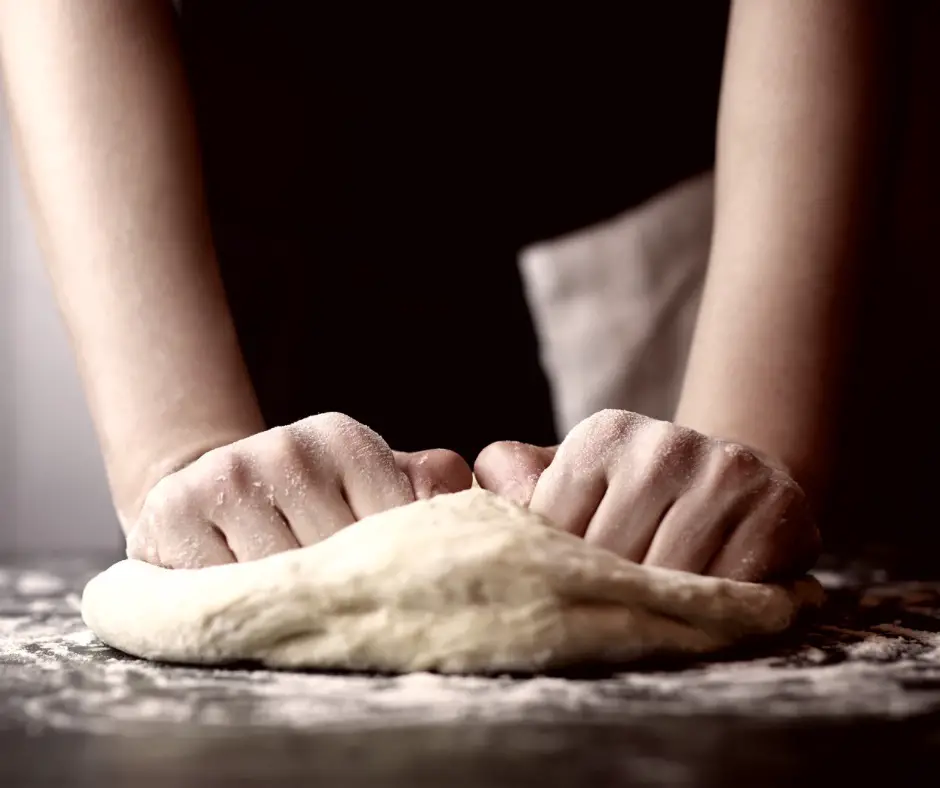Making pizza dough from scratch is a fun and rewarding experience, but it can also be time-consuming.
If you’re short on time, you may be wondering if you can refrigerate pizza dough after it rises.
In this article, we’ll discuss the benefits of refrigerating pizza dough, as well as how to do it properly.
We’ll also provide some tips for making the most of your refrigerated pizza dough.

Can You Refrigerate Pizza Dough Before It Rises?
Absolutely!
You can certainly chill your pizza dough before it has a chance to rise and you may even find, like many do, that this actually enhances the dough’s flavor.
Why might you ask?
Well, when we refrigerate the dough, we slow down the yeast’s activity allowing our pizza to develop a deep, complex flavor profile analogous to robust sourdough.
You’ll note this contrast significantly with the more simple flavors yielded from a dough proofed on your countertop.
What’s interesting is that the method of chilling also affects your pizza’s texture.
The slowed yeast activity means fewer bubbles escape from the dough during rising which in turn gifts us with a final product boasting an enticing open crumb texture and good elasticity.
Yet, remember that taste and texture will also depend on other factors such as the type of yeast used or if a pre-ferment was incorporated into your recipe.
Nevertheless, slower yeast action generally promises more flavorful outcomes.
Ready to give it a try?
Simply pop your dough in a lightly greased bowl, cover it snugly with plastic wrap and send it off for its chilly sleepover in your fridge for up to 24 hours.
If you’ve made enough for multiple pizzas, divide up your dough into portions and stow each away in separate containers or bags.
When pizza day arrives, take out your dough from its cold abode allowing it to reach room temperature over about an hour before embarking on shaping and baking.
Can You Refrigerate Pizza Dough After It Rises?
You can, indeed, refrigerate your pizza dough even after it has risen.
The process is pretty straightforward.
Begin by gently deflating your dough through a brief kneading session.
Once that’s done, divide your dough into necessary portions and shape them into tight balls.
These prep steps make the dough easy to work with when you’re ready to roll it out for pizza later.
Once you have your dough balls, move them onto a floured tray and cover with plastic wrap.
Then into the fridge they go!
Your dough can chill there happily for up to 24 hours.
Can You Refrigerate Pizza Dough After Second Rise?
The answer to that is yes, you can!
However, there’s a word of caution to heed.
If pizza dough is kept in the fridge for too long after its second rise, it could end up overproofing.
Why so?
As yeast – the magical rising agent – feeds on the sugars in your dough, it produces carbon dioxide which causes your dough to rise.
If left for an extended period in the fridge, the yeasts could consume most of these sugars resulting in a dough that doesn’t rise as you’d expect.
So while refrigeration does offer flexibility and control over when you bake your pizza, remember not to let your dough cold-ferment for too long after that second proofing stage.
How Long Can You Store Pizza Dough In The Fridge?
The lifespan of your dough is influenced by a few factors including yeast levels, water temperature and the overall quality of your dough.
As a rule of thumb, pizza dough can comfortably sit in the fridge for up to 5 days.
Why not longer?
You see, while cooler temperatures do slow down yeast activity (they’re behind the magic of fermentation), they don’t bring it to a complete halt.
So if you’re planning on long-term fridge storage, consider cutting back on the yeast in your recipe to avoid over-fermentation during this period.
Storing pizza dough is easy.
Post the first rise, portion out your dough and wrap it tightly with plastic wrap or stash it into an airtight container.
Allow a little space for expansion as the slow fermentation process will continue inside your fridge.
When you’re ready for homemade pizza goodness, remove your chilled dough and place it either on your countertop or in a lightly floured bowl.
Loosely cover it and let it relax until it’s room temperature – typically about an hour.
Now, you’re all set to stretch out that soft and pliable ball of yum into your pizza base.
Got more dough than you can handle right now? No worries!
Your freezer is also an excellent storage option offering up to 3 months of preservation.
Bundle up your portioned dough as described above but instead put each bundle into a freezer bag making sure to squeeze out any excess air before sealing.
Don’t forget to label and date each bag before freezing them flat!
How To Use Pizza Dough From Fridge
Retrieving and using pizza dough you’ve stored in the fridge is a cinch and can be incredibly handy for last-minute homemade pizza nights!
Firstly, to get your chilled dough ready for action, remove it from the fridge around an hour before you plan to bake.
This allows the dough ample time to warm up to room temperature, making it much more cooperative when it comes to stretching and shaping.
Next, unwrap your dough.
Then place it on the countertop or place it in a lightly floured bowl.
To prevent your dough from drying out during this resting period, loosely cover it with a damp cloth or some plastic wrap.
Once your dough feels soft and pliable – that’s when you’ll know its room temperature – transfer it onto a lightly floured surface.
Here’s where you get to be hands-on: stretch out that dough into your preferred pizza crust shape.
Whether you like using a rolling pin or prefer the feel of pressing out the crust with your own hands is entirely up to you.
Now onto arguably the most fun part: Topping!
Slather on your favorite sauce, sprinkle generously with cheese, add toppings galore (or keep them minimal if that’s how you roll) and perhaps even brush some olive oil around the crust edges for an added flavor punch and extra crispiness.
It’s showtime!
Slide your dressed-up pizza onto a preheated pizza stone or baking sheet (500°F should do it). Bake for about 7-10 minutes until the cheese forms alluring bubbles and the crust turns golden.

